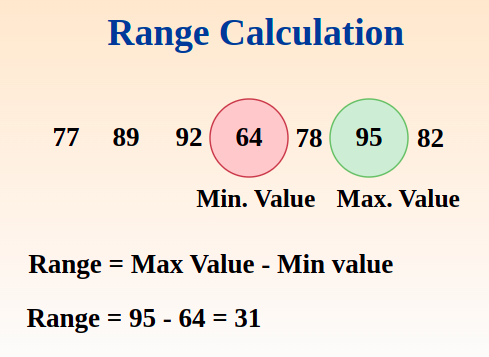Understanding Range in Statistics
Range is one of the simplest measures of dispersion, indicating how spread out a dataset is. It is calculated using the highest and lowest observations in a dataset. Despite its simplicity, the range can be heavily influenced by outliers, which might skew the interpretation of data spread.
To gain a more comprehensive understanding of data variability, the range should be used alongside other measures of dispersion, such as variance and standard deviation. In this article, we will discuss how to calculate the range for any dataset using a straightforward formula.
What is Range in Statistics?
The range is a measure of variability in statistics, representing the difference between the highest and lowest values in a dataset. It helps to determine the spread of numbers or data from the lowest to the highest value.
For instance, in a dataset {2, 5, 8, 10, 3}, the range is calculated as 10 – 2 = 8. This simple calculation gives a quick understanding of the distribution of data points.
Range Formula
The formula for the range in statistics is:
Or equivalently:
How to Calculate the Range in Statistics
Here’s a step-by-step guide to finding the range in statistics:
- Arrange the values in ascending order: Write down all values from lowest to highest.
- Identify the highest and lowest values in the dataset.
- Subtract the lowest value from the highest value to find the range.
Let’s consider an example for better understanding.
Example:
The number of hours spent by employees commuting to work in a week are: 30, 31, 35, 49, 45, 50. Determine the range of commuting hours.
Solution:
Given dataset: 30, 31, 35, 49, 45, 50
Arranging the data in ascending order: 30, 31, 35, 45, 49, 50
Hence, the range of the given dataset is 20.
More Examples on Calculating Range
Example 1:
The number of goals scored by a football team in seven matches are: 2, 3, 1, 4, 2, 5, 9. Determine the range of goals scored.
Solution:
Given dataset: 2, 3, 1, 4, 2, 5, 9
Arranging the data in ascending order: 1, 2, 2, 3, 4, 5, 9
Hence, the range of goals scored in seven matches is 8.
Example 2:
The diameters (in centimeters) of ten oranges are: 7, 8, 9, 10, 12, 8, 9, 11, 13, 10. What is the range of diameters?
Solution:
Given dataset: 7, 8, 9, 10, 12, 8, 9, 11, 13, 10
Arranging the data in ascending order: 7, 8, 8, 9, 9, 10, 10, 11, 12, 13
Hence, the range of the diameters is 6.
Example 3:
The distances (in kilometers) traveled by five cyclists are: 10, 15, 20, 15, 30. Determine the range of distances.
Solution:
Given dataset: 10, 15, 20, 15, 30
Arranging the data in ascending order: 10, 15, 15, 20, 30
Hence, the range of the distances is 20.
Example 4:
The ages (in months) of babies in a daycare center are: 6, 8, 10, 12, 14, 16, 18, 20, 22, 24. What is the range of ages?
Solution:
Given dataset: 6, 8, 10, 12, 14, 16, 18, 20, 22, 24
Arranging the data in ascending order: 6, 8, 10, 12, 14, 16, 18, 20, 22, 24
Hence, the range of ages is 18.
Practice Questions on Range
- Find the range of the following set of numbers: {4, 6, 8, 10, 12}.
- In a math class, the test scores of six students are: 85, 92, 78, 90, 88, 95. Determine the range of scores.
- The ages of children in a classroom are: 6, 7, 6, 8, 9, 7, 6, 10, 11. What is the range of ages?
- The heights (in centimeters) of students in a class are: 156, 162, 169, 155, 175, 180, 150, 172, 168, 178. What is the range of heights?
- A company has recorded the following profits (in thousands of dollars) over five years: $200, $300, $250, $400, $600. Calculate the range of profits.
- The temperatures (in degrees Celsius) recorded over a week are: 20, 22, 18, 25, 23, 21, 24. What is the range of temperatures?
- The number of hours spent studying for a test by eight students is: 4, 6, 3, 7, 5, 8, 2, 5. Determine the range of study hours.how to calculate range




